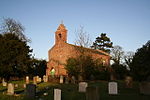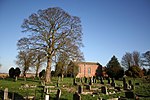Langrick Bridge

Langrick Bridge is a village in the civil parish of Holland Fen with Brothertoft in the Borough of Boston, Lincolnshire, England. The village is in the Lincolnshire Fens, 5 miles (8 km) north-west of Boston and 24 miles (40 km) south-east of Lincoln. It is at the southern side of the bridge of the same name which spans the River Witham. At the north side of the bridge the settlement is in the civil parish of Langriville. The southern boundary of the village of Langrick is 200 yards (180 m) north from the bridge.The bridge has moorings on both banks, the next nearest moorings being 5 miles (8 km) upstream at Chapel Hill, and 2 miles (3 km) downstream at Anton's Gowt. The B1192 Coningsby to Kirton road runs through the settlement, which at the north of the bridge is Main Road, and at the south is Langrick Road that has an immediate junction with Ferry Lane which runs west to the North Forty Foot Bank.It was formerly served by Langrick railway station. Closest to the bridge is Witham House, a Grade II listed two-storey building, dating to the early 18th century with later additions. To the south of the bridge on Ferry Lane and Langrick Road are detached and semi-detached houses, two farms, a fuel station, a shop selling boating equipment and food supplies, and a former Wesleyan Methodist chapel, built of red brick, with a datestone inscribed with '1868'.
Excerpt from the Wikipedia article Langrick Bridge (License: CC BY-SA 3.0, Authors, Images).Langrick Bridge
Langrick Bridge,
Geographical coordinates (GPS) Address Nearby Places Show on map
Geographical coordinates (GPS)
| Latitude | Longitude |
|---|---|
| N 53.0102 ° | E -0.11471 ° |
Address
Langrick Bridge
Langrick Bridge
PE22 7AJ , Holland Fen with Brothertoft
England, United Kingdom
Open on Google Maps









